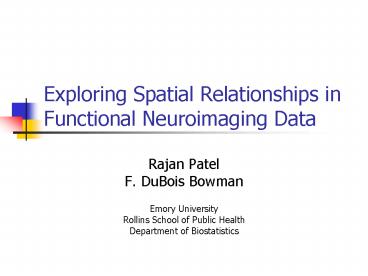Exploring Spatial Relationships in Functional Neuroimaging Data PowerPoint PPT Presentation
1 / 21
Title: Exploring Spatial Relationships in Functional Neuroimaging Data
1
Exploring Spatial Relationships in Functional
Neuroimaging Data
- Rajan Patel
- F. DuBois Bowman
- Emory University
- Rollins School of Public Health
- Department of Biostatistics
2
Overview
- Gain insight into the organization of human brain
function by classifying localized brain regions
that exhibit similar patterns of activity - Examine data structure from a PET study
- Present new and existing clustering methods,
stopping rules, and a performance evaluation a
criterion - Conduct empirical analysis
- Identify clustering methods that perform well for
PET functional neuroimaging data
3
PET Data Ethanol Study
- K10 Subjects, each with S4 scans
- LOW dose ethanol Scan 2
- HIGH dose ethanol Scan 3
- Subjects complete continuous performance tasks
during each scan - We apply clustering methods to
- Identify collections of voxels that exhibit
similar ethanol-induced changes in neural
processing - Characterize brain activity patterns within each
cluster
4
PET data (2)
- Represents serial rCBF for subject k at voxel v.
- We calculate a summary measure across individuals
by implementing a general linear model. - Let X denote a matrix of design variables with
columns corresponding to the scan numbers a final
column containing a covariate adjustment for
gCBF. - We will cluster brain voxels based on this
vector.
5
Functional Distance
- Define the functional distance between two voxels
as - where BVi,Vj is a positive semi-definite matrix
(inverse of the covariance matrix). - We create a partition of the V voxels into G
clusters, attempt to group voxels with small
distances.
6
Visual Distance Matrix
7
Clustering Methods
- Hierarchical Methods
- Form a hierarchy of nested cluster solutions
- We compare several existing methods
- We introduce a new method
- Variable Linkage
- Generalization of kth nearest neighbor clustering
- k is a function of the size of the two clusters
8
Clustering Methods (2)
- Stopping rules for hierarchical methods
- Determine the optimal number of clusters
- (where to stop on the hierarchical clustering
tree) - 3 methods we compare are
- Pseudo-F (Calinski and Habarasz, 1974)
- Pseudo-t2 (Duda and Hart, 1973)
- Cubic Clustering Criterion (CCC) (Sarle, 1983)
- Provided by SAS
9
Clustering Methods (3)
- Partitioning Methods
- Separates observations into predefined number of
subgroups based on functional distance - Examples
- K-Means, Fuzzy K-Means
- Most commonly used in clustering of functional
neuroimaging data. - Less computationally and memory intensive
- Must pre-specify number of clusters
10
Clustering Methods (4)
- Evaluating cluster performance
- F-Score Algorithm
- Requires knowledge of true clustering
- Range from 0 to 1 where 1 represents a perfect
clustering and 0 indicates that no voxels are
correctly classified - Let ?g represent a true cluster, ?g represent a
computed cluster, and Vgg be the number of
voxels in both ?g and ?g
11
Simulation Study
- Empirical analysis of 100 simulated data sets
with 11 actual clusters with properties based on
ethanol data set - Also considered 100 simulated data sets with
additional noise - Analyze clustering results of hierarchical and
partitioning clustering algorithms - Compare F-Score values at 11 clusters
- Analyze accuracy of stopping rules for each
clustering algorithm
12
Results (1)
13
Results (2)
14
Results (3)
15
Results (4)
16
Results (5)
17
Results (6)
18
Results (7)
The figure shows the two clusters that exhibit
the largest ethanol-related decrease in rCBF
(Scan 1 Scan 4), based on Wards method. The
two clusters are located in the cerebellum, which
controls coordinated movement of the body.
19
Summary
- Wards Method, Beta-Flexible recommended
- F-Score values consistently high
- Stopping rules work the best
- K-Means, Fuzzy K-Means
- F-Scores relatively high for noisy data
- Stopping rules do not work as well
- Pseudo-F, CCC, and Pseudo-t2 worked well for many
of the hierarchical algorithms with the standard
simulated data - Pseudo-F produced more accurate results than CCC
and Pseudo-t2 for noisy data - For PET data, we recommend Wards Method or
Beta-Flexible in conjunction with a simultaneous
inspection of Pseudo-F, CCC, and Pseudo-t2 - For noisy data, we recommend Wards Method or
Beta-Flexible in conjunction with Pseudo-F
20
K-Means Explanation
K Means Clustering (11 clusters)
Actual Clustering Simulated
Data Noisy Data
21
K-Means Explanation (2)

